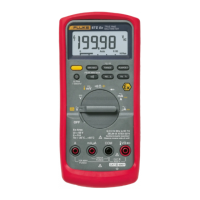87V Ex
Users Manual
4
• Ensure the battery door is closed and
latched whenever operating the Meter.
• Replace the battery as soon as the
battery indicator (M) appears. See
“Replacing the Battery” section for
instructions and a list of approved
batteries.
• Remove test leads from the Meter before
opening the battery door.
• Inspect the test leads for damaged
insulation or exposed metal. Check the
test leads for continuity. Replace
damaged leads before using the Meter.
• Do not apply more than the rated
voltage, as marked on the Meter,
between the terminals or between any
terminal and earth ground.
• Use caution when working with voltages
above 30 V ac rms, 42 V ac peak, or 60 V
dc. These voltages pose a shock hazard.
• Use only the replacement fuses specified
in this Users Manual. See “Replacing the
Fuses” section for instructions and a list
of approved fuses.
• Use the proper terminals, function, and
range for measurements.
• Avoid working alone.
• When measuring current, turn off circuit
power before connecting the Meter to the
circuit. Remember to place the Meter in
series with the circuit.
• When making electrical connections,
connect the common test lead before
connecting the live test lead; when
disconnecting, disconnect the live test
lead before disconnecting the common
test lead.
• Do not use the Meter if it operates
abnormally. Protection may be impaired.
When in doubt, have the Meter serviced.
• Use only a single 9 volt battery, properly
installed in the Meter case, to power the
Meter. See “Replacing the Battery”
section for instructions and a list of
approved batteries.
• Only use replacement parts listed in the
“Parts” section of this manual. Return
the Meter to the manufacturer for all
other service needs.
• When using probes, keep your
fingers behind the probe’s finger
guards.

